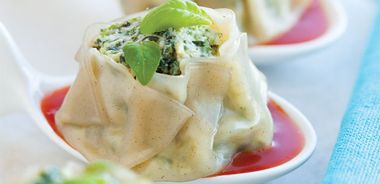Italian Steamed Dumplings

These steamed dumplings are a scrumptious take on their Asian cousins. A relative of the turnip family, broccoli rabe has long, thin leafy stalks topped with small florets. Very low in calories, this star green gets a nutritional high-five for being an excellent source of vitamin K, iron, and calcium.
1 cup (250 mL) low-fat ricotta cheese
1 small bunch broccoli rabe, about 1/2 lb (225 g), trimmed
1 Tbsp (15 mL) coconut oil
1 Tbsp (15 mL) minced garlic
3 Tbsp (45 mL) pine nuts
1/4 cup (60 mL) fresh basil leaves, torn
Freshly ground black pepper, to taste
Cornstarch, for dusting
36 round dumpling skins
3/4 cup (180 mL) low-sodium or homemade tomato sauce, warmed
Small basil leaves, for garnish
Line bowl with a double layer of cheesecloth. Add ricotta to bowl and wrap cheesecloth around ricotta, gently squeezing out as much water as possible into bowl. Discard liquid and set drained ricotta aside.
To make dumpling filling, bring large saucepan of salted water to a boil. Prepare an ice bath by filling large bowl with cold water and adding a handful of ice. Add broccoli rabe to boiling water and cook until tender and bright green, about 1 minute. Drain and transfer to ice bath to stop the cooking process. Drain again and coarsely chop.
Heat oil in frying pan over medium heat. Add garlic and fry until golden, about 30 seconds. Stir in broccoli rabe and pine nuts and cook, stirring often, until nuts start to brown, about 3 to 4 minutes. Transfer to bowl of food processor fitted with steel blade attachment. Add drained ricotta, basil, and a few grinds of pepper. Pulse until finely chopped and well incorporated (but not puréed), scraping down sides of processor as needed.
Lightly dust parchment-lined baking tray with cornstarch.
Working with one dumpling skin at a time, use fingertip to wet edge of both sides of skin with water. Place heaping 1 tsp (5 mL) ball of filling mixture into centre. Draw up one edge, making a small pleat. Squeeze pleat firmly together before continuing to make pleats until filling is encased. Pinch pleats together at top to ensure dumpling is sealed. Place dumpling on prepared baking tray and loosely cover with clean kitchen towel. Continue making dumplings, using up all skins and filling.
Fill wok or medium saucepan with about 2 to 3 in (5 to 8 cm) of water and bring to a boil. Reduce heat to medium and bring water to a simmer. Cut rounds of parchment paper to fit inside 2 large bamboo steamer bases. Brush off cornstarch from dumplings and place in steamer, leaving about 1/2 in (1.25 cm) between each one. Stack bases on top of each other and add steamer lid. Place over simmering water and allow dumplings to steam until wrappers are soft and filling is warm, about 8 to 10 minutes. Switch positions of top and bottom steamer basket about halfway through.
To serve, place 1 tsp (5 mL) tomato sauce on Chinese soup spoon and place warm dumpling on top. Garnish with fresh basil, if desired. Dumplings can also be served on a platter with tomato sauce on the side for dipping.
Makes 36 dumplings.
Each dumpling contains: 45 calories; 2 g protein; 2 g total fat (1 g sat. fat, 0 g trans fat); 6 g total carbohydrates (0 g sugars, 0 g fibre); 57 mg sodium
source: "Happy New Year!", alive #374, December 2013





